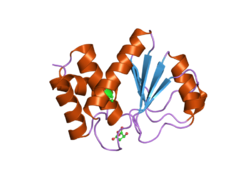| DUSP23 |
|---|
 |
| Available structures |
|---|
| PDB | Ortholog search: PDBe RCSB |
|---|
| List of PDB id codes |
|---|
2IMG, 4ERC |
|
|
| Identifiers |
|---|
| Aliases | DUSP23, DUSP25, LDP-3, MOSP, VHZ, dual specificity phosphatase 23, LDP3 |
|---|
| External IDs | OMIM: 618361; MGI: 1915690; HomoloGene: 32368; GeneCards: DUSP23; OMA:DUSP23 - orthologs |
|---|
| Gene location (Human) |
|---|
 | | Chr. | Chromosome 1 (human)[1] |
|---|
| | Band | 1q23.2 | Start | 159,780,932 bp[1] |
|---|
| End | 159,782,543 bp[1] |
|---|
|
| Gene location (Mouse) |
|---|
 | | Chr. | Chromosome 1 (mouse)[2] |
|---|
| | Band | 1|1 H3 | Start | 172,458,331 bp[2] |
|---|
| End | 172,460,529 bp[2] |
|---|
|
| RNA expression pattern |
|---|
| Bgee | | Human | Mouse (ortholog) |
|---|
| Top expressed in | - left adrenal cortex
- olfactory zone of nasal mucosa
- right lobe of liver
- right adrenal gland
- minor salivary glands
- right adrenal cortex
- mucosa of transverse colon
- human kidney
- mucosa of esophagus
- tendon of biceps brachii
|
| | Top expressed in | - muscle of thigh
- skeletal muscle tissue
- right kidney
- triceps brachii muscle
- quadriceps femoris muscle
- interventricular septum
- sternocleidomastoid muscle
- vastus lateralis muscle
- medial head of gastrocnemius muscle
- zygote
|
| | More reference expression data |
|
|---|
| BioGPS | |
|---|
|
| Gene ontology |
|---|
| Molecular function | - protein tyrosine phosphatase activity
- protein serine/threonine phosphatase activity
- phosphoprotein phosphatase activity
- hydrolase activity
- protein binding
- phosphatase activity
- protein tyrosine/serine/threonine phosphatase activity
| | Cellular component | - cytoplasm
- cytosol
- nucleus
- nucleoplasm
| | Biological process | - protein dephosphorylation
- dephosphorylation
- peptidyl-tyrosine dephosphorylation
| | Sources:Amigo / QuickGO |
|
| Orthologs |
|---|
| Species | Human | Mouse |
|---|
| Entrez | | |
|---|
| Ensembl | | |
|---|
| UniProt | | |
|---|
| RefSeq (mRNA) | |
|---|
NM_017823
NM_001319658
NM_001319659 |
| |
|---|
| RefSeq (protein) | |
|---|
NP_001306587
NP_001306588
NP_060293 |
| |
|---|
| Location (UCSC) | Chr 1: 159.78 – 159.78 Mb | Chr 1: 172.46 – 172.46 Mb |
|---|
| PubMed search | [3] | [4] |
|---|
|
| Wikidata |
| View/Edit Human | View/Edit Mouse |
|

 2img: Crystal structure of dual specificity protein phosphatase 23 from Homo sapiens in complex with ligand malate ion
2img: Crystal structure of dual specificity protein phosphatase 23 from Homo sapiens in complex with ligand malate ion

















